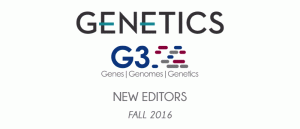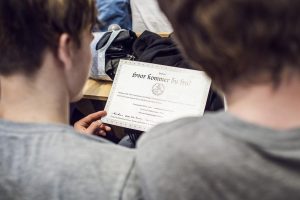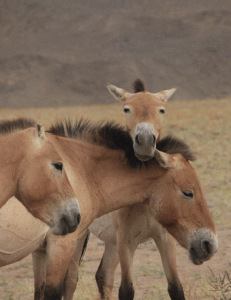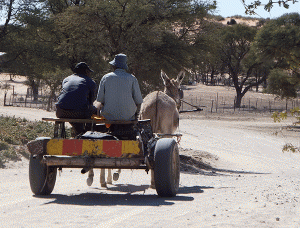Enter your address to receive notifications about new posts to your email.
Articles tagged Genetics Journal
(334 results)
-
December GENETICS Highlights
Check out the December issue of GENETICS by looking at the highlights or the full table of contents! ISSUE HIGHLIGHTS This Month’s Centennial Articles Edward East on the Mendelian basis of quantitative trait variation, pp. 1321-1323 Michael Turelli Reviews editor Michael Turelli introduces Edward East’s 1916 Classic on the Mendelian basis of a continuously varying phenotype. This work exquisitely…
-
GENETICS and G3 Fall 2016 Editorial Board Update
GENETICS and G3 are excited to welcome new editors! GENETICS and G3 Series Editor: Lauren McIntyre GENETICS Associate Editors: Anne Britt, Elizabeth Hauser, Jennifer Surtees, Paul Scheet, Mikko J. Sillanpää, Mario Calus, Katie Peichel G3 Associate Editors: Michael J. Axtell, Fernando Pardo-Manuel de Villena, Shavannor M. Smith, Joshua Udall GENETICS and G3 Series Editor LAUREN MCINTYRE University of Florida Lauren McIntyre is developing a…
-
November GENETICS Highlights
Check out the November issue of GENETICS by looking at the highlights or the full table of contents! ISSUE HIGHLIGHTS This Month’s Centennial Articles Charlesworth et al. on background selection and neutral diversity, pp. 829-832 Stephen I. Wright Associate Editor Stephen I. Wright introduces the 1993 GENETICS Classic by Charlesworth. This landmark article revealed an important effect structuring neutral…
-
Using yeast to expose cancer’s genetic vulnerabilities
Cancer profoundly scars the genome of an affected cell. Amplification and overexpression of chunks of DNA sequence are common—but it’s not always clear whether these changes are directly involved in the disease or byproducts of some other malfunction. Further complicating the search for treatments, many genes that are altered in cancer cells are involved in…
-
GSA Journals Spotlight 2015
The GSA Journals, GENETICS and G3: Genes|Genomes|Genetics, are proud to present our annual Spotlight booklets for research published in 2015. Each Spotlight is a showcase of the excellent research and scholarship published over the course of the year, along with a selection of striking images submitted by our authors. Browse the 2015 GENETICS Spotlight. Browse the 2015 G3 Spotlight. …
-
Genomic study of high school students from across Denmark reveals remarkable genetic homogeneity
People from Denmark are genetically similar to each other no matter which part of the country they come from, report researchers in the journal GENETICS, a publication of the Genetics Society of America. Eight hundred Danish high school students contributed genetic material to the Where Are You From? project, and the data were used to…
-
October GENETICS Highlights
Check out the October issue of GENETICS by looking at the highlights or the full table of contents! ISSUE HIGHLIGHTS This Month’s Centennial Articles Fumio Tajima and the origin of modern population genetics, pp. 389–390 Rasmus Nielsen Associate Editor Rasmus Nielsen introduces Fumio Tajima’s 1983 Classic on coalescence. This was one of the founding papers of modern population genetics…
-
Kindred and KhoeSan: African ancestry is tied to ecogeography
Geography and ecology are key factors that have influenced the genetic makeup of human groups in southern Africa, according to new research discussed in the journal GENETICS, a publication of the Genetics Society of America. By investigating the ancestries of twenty-two KhoeSan groups, including new samples from the Nama and the ≠Khomani, researchers conclude that…
-
September GENETICS Highlights
Check out the September issue of GENETICS by looking at the highlights or the full table of contents! ISSUE HIGHLIGHTS This Month’s Centennial Articles Sydney Brenner on the genetics of Caenorhabditis elegans, pp. 1-2 Bob Goldstein Associate Editor Bob Goldstein introduces the 1974 Classic reporting Sydney Brenner’s first Caenorhabditis elegans mutant screens, stimulating discoveries from thousands of researchers that…
-
Trying to Find your Way in the Nervous System? C. elegans can help!
Guest post by Daniel G. Taub. With billions of neurons in the human brain, making the right connections during development seems a daunting task. A developing neuron often follows the lead of trailblazers, using existing bundles of axons called axonal tracts as a guide. But how does the original axonal tract get laid down? In…
-
August GENETICS Highlights
Check out the August issue of GENETICS by looking at the highlights or the full table of contents! ISSUE HIGHLIGHTS This Month’s Centennial Articles Horvitz and Sulston on Caenorhabditis elegans cell lineage mutants, pp. 1485-1487 Kenneth J. Kemphues Kenneth Kemphues introduces Horvitz and Sulston’s 1980 GENETICS Classic, which demonstrated that systematic mutational analysis could dissect the regulation of the…











